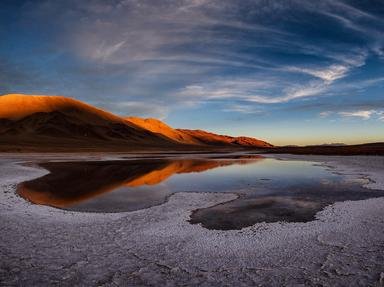Quiz Answer Key and Fun Facts
1. As we prepare for our grand tour, the good doctor straps a case of Kleenex to my back muttering about the usefulness of facial tissue. He claims it makes a good jewelry buffer cloth and proceeds to explain that the name Argentina refers to some precious metal, although he can't remember which, do you know?
2. Dr. Johnson continued to mumble about heathen chilies he'd encountered in his previous tours. I thought him confused and handed him a tissue to wipe his nose, a consequence of our current altitude high in which mountain range that makes up the border between Argentina and Chile?
3. Some say the good doctor is a germaphobe, thus the amount of sweating that commenced while viewing 12,000 year old artwork deep within a cave along the Pinturas River was understandable. He barely could eke out the name of the cave, whispering in muffled tones, Cueva de las what?
4. I handed Dr. Johnson another tissue as we explored the salt flats of a barren land mass that has some of the lowest elevations in Argentina. He eyed some nearby seals while holding the tissue over his mouth and I was barely able to hear him say "those UNESCO people need to get with Exxon and do something about all these seals" on which peninsula?
5. Dr. Johnson was crying, but I rather enjoyed the good air in the cool of the evening as we walked along the Plaza Mitre watching two couples tango. "That dance of their inventions, it's so beautiful," he sobbed as the two bodies moved in unison. I handed him a tissue and we progressed through the streets of what city?
6. Eyes watering, I stood with Dr. Johnson on a knoll surveying a vast grassland. Wiping his similarly watery eyes with the tissue I handed him, the doctor sneezed and gestured to the waving fronds synonymous with what geographic location?
7. Dr. Johnson and I continued in our travels, following the Santa Cruz River to its source. The poor doctor was blue and cold, covering his nose with a tissue as we surveyed the icebergs floating in the largest freshwater lake in the country, a body of water called what?
8. I was definitely pleased with my preparations as Dr. Johnson and I began to summit the highest mountain in the Southern Hemisphere. Dr. Johnson, however, was not as impressed as I'd packed too many boxes of tissues for our climb of which non-technical peak?
9. Our journey took us further south where we surveyed the Patagonia. Muffled in his goose-down parka, Dr. Johnson's cold brain mumbled random thoughts, "Magellan thought the inhabitants here were giants. Some think this region was likely part of the (muffled) continent." I didn't quite make out the continent he mumbled, can you help me out?
10. Since we were nearby, we decided to visit the Patagonia's most celebrated piece of ice. The good doctor chipped off a chunk as a souvenir, commenting that this spectacular display was "still growing," baffling his colleagues but delighting millions of annual visitors. Awe-struck, I merely nodded, dabbing my moist eyes with a tissue as I admired what?
Source: Author
TemptressToo
This quiz was reviewed by FunTrivia editor
Tizzabelle before going online.
Any errors found in FunTrivia content are routinely corrected through our feedback system.
